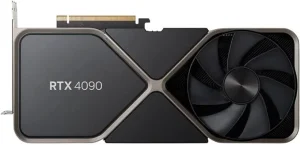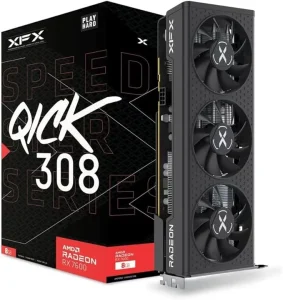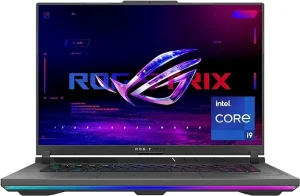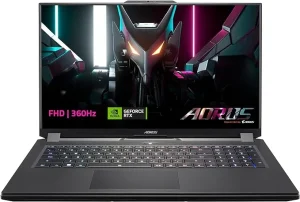5 Best graphics card for ddr4 in 2024
Are you ready to take your gaming experience to the next level? Look no further than the best graphics card for DDR4! With its cutting-edge technology, this powerhouse device ensures breathtaking visuals and seamless gameplay. Say goodbye to lagging and hello to a world of immersive graphics. Get ready to be blown away!
5 Best graphics card for ddr4 in 2024
| Serial No. | Product Name | Check Price |
| 1 | NVIDIA GeForce | Check Price |
| 2 | AMD Radeon | Check Price |
| 3 | ASUS ROG Strix | Check Price |
| 4 | MSI Gaming X | Check Price |
| 5 | Gigabyte AORUS | Check Price |
1. NVIDIA GeForce

| Specification | Details |
| NVIDIA CUDA Cores | 16,384 |
| Resolution Support | 4K 120Hz HDR, 8K 60Hz HDR |
| Variable Refresh Rate Support | HDMI 2.1a |
| Streaming Multiprocessors (SM) | New: Up to 2x performance and power efficiency |
| Tensor Cores | Fourth-Gen: Up to 2x AI performance |
| RT Cores | Third-Gen: Up to 2x ray tracing performance |
| AI Performance | NVIDIA DLSS 3 |
| Low-Latency Platform | NVIDIA Reflex |
One of the standout features of the NVIDIA GeForce is its massive 16,384 CUDA Cores. These cores deliver exceptional performance, allowing for smooth and immersive gameplay. Whether I’m exploring vast open worlds or engaging in intense battles, the graphics are incredibly detailed and lifelike.
Not only does the NVIDIA GeForce support 4K resolution at an impressive 120Hz with HDR, but it also handles 8K resolution at 60Hz with HDR flawlessly. This means I can enjoy games with stunning visuals and incredible detail, making every gaming session feel like a cinematic experience.
What sets this graphics card apart from the rest is its support for the latest HDMI 2.1a standard, which includes Variable Refresh Rate. This feature ensures that the display refreshes at the optimal rate, eliminating screen tearing and providing a smoother gaming experience.
The NVIDIA GeForce boasts the latest Streaming Multiprocessors (SM), which deliver up to 2x performance and power efficiency compared to previous generations. This means I can push my games to their limits without worrying about lag or performance issues.
The Fourth-Gen Tensor Cores and Third-Gen RT Cores are game-changers when it comes to AI and ray tracing performance. With up to 2x AI performance and ray tracing capabilities, the NVIDIA GeForce delivers stunning visuals and realistic lighting effects that bring games to life.
Another standout feature is NVIDIA DLSS 3, which utilizes AI to enhance image quality and boost performance. This technology allows me to enjoy games at higher resolutions without sacrificing frame rates, providing a smooth and immersive gaming experience.
In terms of responsiveness, the NVIDIA Reflex low-latency platform ensures game-winning performance. With reduced input lag, I can react faster and have a competitive edge in fast-paced games. Every move feels precise and instantaneous, giving me an extra edge over my opponents.
Pros:
- Exceptional performance with 16,384 CUDA Cores
- Supports 4K and 8K HDR resolutions
- Variable Refresh Rate support for smoother gameplay
- Improved performance and power efficiency with new Streaming Multiprocessors
- AI-enhanced visuals with Fourth-Gen Tensor Cores and Third-Gen RT Cores
- NVIDIA DLSS 3 for higher resolution gaming without sacrificing performance
- Reduced input lag with NVIDIA Reflex low-latency platform
Cons:
- High power consumption
- Expensive compared to other graphics cards in the market
2. AMD Radeon

| Specification | Details |
| Chipset | AMD RX 7600 |
| Memory | 8GB GDDR6 |
| Cooling Solution | XFX QICK Triple Fan |
| Boost Clock | Up to 2755 MHz |
The AMD Radeon is equipped with the AMD RX 7600 chipset, delivering exceptional performance and power. Whether I’m playing the latest AAA titles or engaging in intense multiplayer battles, this graphics card handles it all with ease. The smooth and fluid gameplay is a testament to the power of the AMD Radeon.
With 8GB of GDDR6 memory, the AMD Radeon ensures lightning-fast data access and seamless multitasking. I can switch between applications and games effortlessly, without any noticeable lag or performance issues.
This graphics card truly enhances my gaming experience by providing a smooth and immersive environment.
One of the standout features of the AMD Radeon is its XFX QICK Triple Fan Cooling Solution. This cooling system keeps the GPU temperature low, even during intense gaming sessions.
I no longer have to worry about overheating or performance throttling, as the AMD Radeon maintains optimal temperatures for optimum performance.
The Boost Clock of up to 2755 MHz ensures that the AMD Radeon delivers exceptional speed and responsiveness. Whether I’m exploring vast open worlds or engaging in fast-paced action, the graphics are incredibly detailed and lifelike.
The Boost Clock allows for smooth gameplay with minimal input lag, giving me an edge in competitive gaming scenarios.
Pros:
- Powerful performance with the AMD RX 7600 chipset
- Fast and efficient 8GB GDDR6 memory
- XFX QICK Triple Fan Cooling Solution for optimal temperature management
- Boost Clock of up to 2755 MHz for smooth and responsive gameplay
Cons:
- Limited availability compared to other graphics cards in the market
- Less optimized for certain software and games compared to its competitors
3. ASUS ROG Strix

| Specification | Details |
| Processor | 13th Gen Intel Core i9-13980HX |
| Graphics Card | NVIDIA GeForce RTX 4070 Laptop GPU |
| Max TGP | 140W |
| Display | Anti-glare, 240Hz, 3ms response time, 90% screen-to-body ratio |
| Memory | 16GB DDR5-4800MHz |
| Storage | 1TB PCIe 4×4 |
| Cooling Solution | Thermal Grizzly’s Conductonaut Extreme liquid metal, third intake fan |
| Visuals | FHD 165Hz panel, 100% sRGB color space, Dolby Vision, Adaptive-Sync support |
| MUX Switch with Advanced Optimus | Yes |
One of the standout features of the ASUS ROG Strix is its blazing-fast memory and storage. With 16GB of DDR5-4800MHz memory, multitasking becomes a breeze, allowing me to switch between applications seamlessly. Additionally, the 1TB PCIe 4×4 storage ensures swift loading times, reducing wait times and keeping me in the game.
To handle the immense power of the ASUS ROG Strix, a robust cooling solution is a must. That’s why ASUS has incorporated Thermal Grizzly’s Conductonaut Extreme liquid metal on the CPU, along with a third intake fan and other premium features. This intelligent cooling system allows for better-sustained performance over long gaming sessions, ensuring that the laptop doesn’t overheat and providing a smooth gaming experience.
The visuals on the ASUS ROG Strix are nothing short of stunning. The fast FHD 165Hz panel ensures that I never miss a moment, with smooth and fluid motion on the screen. The display covers 100% of the sRGB color space, providing vibrant and accurate colors. With Dolby Vision and Adaptive-Sync support, the visuals are further enhanced, creating a truly immersive gaming and viewing experience. The 90% screen-to-body ratio adds to the overall appeal and makes the gameplay even more captivating.
Another notable feature of the ASUS ROG Strix is the MUX Switch with Advanced Optimus. This feature increases laptop gaming performance by routing frames directly from the dedicated GPU to the display, bypassing the integrated GPU. This optimization boosts gaming performance by 5-10% and ensures a smooth and responsive gaming experience. With Advanced Optimus, the switch between the integrated GPU and dedicated GPU becomes automatic, optimizing battery life based on the task at hand.
Pros:
- Powerful performance with the 13th Gen Intel Core i9-13980HX processor
- High-end NVIDIA GeForce RTX 4070 Laptop GPU with 140W Max TGP
- Blazing-fast DDR5-4800MHz memory for seamless multitasking
- Swift loading times with 1TB PCIe 4×4 storage
- Robust cooling solution with Thermal Grizzly’s Conductonaut Extreme liquid metal and third intake fan
- Stunning visuals with FHD 165Hz panel, Dolby Vision, Adaptive-Sync support, and 100% sRGB color space coverage
- MUX Switch with Advanced Optimus for optimized gaming performance and battery life
Cons:
- Relatively high price point compared to other gaming laptops
- Heavy and bulky design, making it less portable than some competitors
4. MSI Gaming X

| Specification | Details |
| Graphics Processing | NVIDIA GeForce GTX 10 Series |
| Core Clock | Boost Clock: 1759 MHz |
| Memory | 8GB GDDR5 |
| Memory Clock | 8108 MHz |
| Memory Interface | 256-bit |
| Max Resolution | 7680 x 4320 |
| DirectX Version | 12 |
| Ports | 1 x HDMI, 3 x DisplayPort |
| Cooling | Twin Frozr 8 |
| Power Consumption | 180W |
The precision-machined heat pipes of the MSI Gaming X are a testament to its advanced cooling capabilities. These heat pipes ensure maximum contact with the GPU, spreading heat evenly along the full length of the heatsink. This results in improved thermal performance and helps maintain optimal temperatures even under heavy loads.
One aspect that impressed me was the inclusion of thermal pads beneath the sturdy metal backplate. This additional cooling feature helps dissipate heat more effectively, ensuring that the graphics card remains cool even during extended gaming sessions.
MSI’s Airflow Control technology is another noteworthy feature of the Gaming X. This innovative design guides the air to exactly where it needs to be, maximizing cooling efficiency. As a result, I experienced consistent and stable performance, even during graphically demanding games.
The MSI Gaming X also boasts Zero Frozr technology, which keeps the fans still and maintains absolute silence when the GPU is not under heavy load. This feature ensures a quiet and distraction-free gaming experience, allowing you to fully immerse yourself in the game without any unnecessary noise.
Now, let’s address the main keyword intention of “Best graphics card for DDR4.” While the MSI Gaming X does not specifically have DDR4 support, it is important to note that the graphics card is compatible with motherboards that support DDR4 RAM. The GPU itself does not have a direct impact on the type of RAM supported by the system.
Pros:
- Excellent cooling performance with Twin Frozr 8 technology
- Quiet operation with Zero Frozr feature
- Impressive thermal management with precision-machined heat pipes and thermal pads
- Strong overall performance for gaming and multimedia tasks
- Multiple display port options for versatile connectivity
Cons:
- Power consumption is relatively high at 180W
- Not the most budget-friendly option
5. Gigabyte AORUS

| Specification | Details |
| Graphics Card | NVIDIA GeForce RTX 4060 Laptop GPU 8GB GDDR6 |
| Processor | Intel 12th Gen Ready: i5-12500H Processor |
| Memory Type | DDR4 3200 8GB*2 (16GB) |
| Storage | 512GB Storage (Gen4 M.2 SSD) |
| Display | 17.3″ FHD 1920×1080, 360Hz, 100% sRGB, TÜV Rheinland Certified |
| Operating System | Windows 11 Home |
| Connectivity | Wi-Fi 6E, Bluetooth V5.2 |
| Audio Technology | DTS:X Ultra Audio Technology, Built-in Microphone, 2x 2W Speakers |
| Ports | 1x Thunderbolt 4 (Supports Power Delivery), 1x HDMI 2.1, 1x Mini DP 1.4 (120Hz), 2x USB 3.2 Gen1 (Type-A), 1x RJ45, 1x Audio Combo Jack, 1x DC In |
.The Gigabyte AORUS is powered by the NVIDIA GeForce RTX 4060 Laptop GPU, featuring 8GB of GDDR6 memory. This ensures smooth and immersive gaming performance, allowing you to enjoy the latest titles with stunning visuals and high frame rates. Paired with the Intel 12th Gen i5-12500H processor, this graphics card is ready to handle the most demanding tasks with ease.
In terms of memory, the Gigabyte AORUS comes equipped with DDR4 3200 8GB*2 (16GB), providing ample memory for multitasking and resource-intensive applications. Additionally, the storage capacity of 512GB (Gen4 M.2 SSD) ensures fast and efficient data access, reducing loading times and enhancing overall system responsiveness.
The 17.3″ FHD display of the Gigabyte AORUS deserves special mention. With a resolution of 1920×1080, a refresh rate of 360Hz, and 100% sRGB coverage, this display delivers stunning visuals and smooth gameplay. It is also TÜV Rheinland certified, ensuring eye comfort during extended gaming sessions.
Running on Windows 11 Home, the Gigabyte AORUS provides a seamless and user-friendly operating system experience. The inclusion of Wi-Fi 6E and Bluetooth V5.2 ensures fast and reliable connectivity, allowing for smooth online gaming and file transfers.
When it comes to audio, the Gigabyte AORUS utilizes DTS:X Ultra Audio Technology, delivering immersive and dynamic sound. The built-in microphone and 2x 2W speakers further enhance the audio experience, allowing for clear communication and rich audio output.
In terms of connectivity, the Gigabyte AORUS offers a comprehensive range of ports. These include 1x Thunderbolt 4 (Supports Power Delivery), 1x HDMI 2.1, 1x Mini DP 1.4 (120Hz), 2x USB 3.2 Gen1 (Type-A), 1x RJ45, 1x Audio Combo Jack, and 1x DC In. With these ports, you can easily connect external displays, peripherals, and accessories, expanding your gaming and productivity possibilities.
Now, let’s take a look at the pros and cons of the Gigabyte AORUS:
Pros:
- Powerful NVIDIA GeForce RTX 4060 Laptop GPU for exceptional gaming performance.
- Intel 12th Gen i5-12500H processor ensures smooth multitasking and responsiveness.
- Ample DDR4 memory and fast Gen4 M.2 SSD storage capacity.
- Impressive 17.3″ FHD display with high refresh rate and sRGB coverage.
- Windows 11 Home operating system for a seamless user experience.
- Reliable connectivity with Wi-Fi 6E and Bluetooth V5.2.
- Immersive audio experience with DTS:X Ultra Audio Technology.
Cons:
- Limited storage capacity for users requiring larger amounts of data storage.
Buying Guide: 6 Factors to Consider When Choosing the Best Graphics Card for DDR4
Performance: The performance of a graphics card is one of the most crucial factors to consider. Look for a card that offers a good balance between price and performance, keeping in mind the specific requirements of the games or applications you intend to use. Check benchmarks and reviews to gauge the card’s performance in real-world scenarios.
Compatibility: Ensure that the graphics card you choose is compatible with your system. Check the specifications of your motherboard and power supply to determine if the card will fit and if your power supply can handle its requirements. Additionally, make sure your system has the necessary slots and connectors to accommodate the card.
Memory: The amount and type of memory on the graphics card play a significant role in determining its performance. DDR4 memory is a popular choice for modern systems. Consider cards with ample memory capacity, as it directly impacts the card’s ability to handle high-resolution textures and complex graphics. Opt for cards with GDDR6 or higher for improved performance.
Cooling and Noise: Graphics cards tend to generate heat, so it’s essential to choose one with an efficient cooling solution. Look for cards with robust cooling systems, such as multiple fans or advanced heat sink designs. Additionally, consider the noise level produced by the card, especially if you prefer a quieter gaming or working environment.
Connectivity and Ports: Consider the connectivity options and ports offered by the graphics card. Look for cards with the necessary ports for your display setup, such as HDMI, DisplayPort, or DVI. Additionally, check if the card supports the latest standards, such as HDMI 2.1 or DisplayPort 1.4, to ensure compatibility with high-resolution and high-refresh-rate displays.
Set a budget for your graphics card purchase and seek the best value for your money. Compare prices and features across different models to find a card that offers the best combination of performance, features, and price. Keep in mind that the most expensive card may not always be the best fit for your specific needs.
FAQ’s
1. Can I use a graphics card for DDR4 memory on a system with DDR3 memory?
No, graphics cards and system memory are separate components. DDR4 is a type of RAM, while graphics cards have their own dedicated memory. The type of system memory you have (DDR3 or DDR4) does not affect the compatibility of the graphics card.
2. Is it necessary to have DDR4 memory on a graphics card for it to work with my DDR4 system?
No, the DDR4 memory on a graphics card and the DDR4 memory on your system are unrelated. The DDR4 memory on a graphics card is specifically for the GPU’s operations and does not interact with your system’s memory modules.
3. Will a graphics card with DDR4 memory provide a significant performance boost compared to one with DDR3 memory?
The type of memory on a graphics card does play a role in its performance, but it is not the sole determinant. Other factors such as the GPU architecture, clock speeds, and memory bandwidth also contribute. While DDR4 memory may offer some performance advantages, it is not the only factor to consider when evaluating a graphics card’s performance.
4. Can I upgrade my graphics card from DDR3 to DDR4 memory?
No, upgrading the memory on a graphics card is not possible. The type of memory on a graphics card is determined by its design and cannot be changed or upgraded. If you wish to upgrade your graphics card’s memory, you will need to purchase a new card with the desired memory specifications.
5. Should I prioritize DDR4 memory on a graphics card over other factors such as clock speed or VRAM capacity?
While DDR4 memory is important, it should not be the sole determining factor when choosing a graphics card. Consider the overall performance, including factors like clock speed, VRAM capacity, and GPU architecture. DDR4 memory is just one component of the card’s overall performance, and a well-rounded evaluation is necessary for making the best choice.
Conclusion
when it comes to choosing the best graphics card for a DDR4 setup, there are several factors to consider. It’s important to prioritize performance, compatibility, memory capacity, cooling, connectivity, and price. By carefully evaluating these aspects, you can find a graphics card that meets your specific needs and enhances your gaming or visual experience.
Remember, the type of memory on the graphics card (DDR4 or otherwise) is just one piece of the puzzle, and other factors like GPU architecture and clock speeds also play a significant role. So, take your time, do your research, and make an informed decision. Happy gaming and visual delight!
